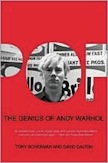 Pop: The Genius of Andy Warhol
Pop: The Genius of Andy Warhol
by Tony Scherman and David Dalton
HarperCollins. 510 pages, $40.
IN THE PAST TWO YEARS, at least two dozen books about Warhol’s life, career, and work have been produced. Is there anything new to say? Tony Scherman and David Dalton’s Pop is an entirely new take on Warhol and his world. Scherman, an award-winning writer about pop Americana, and David Dalton, a founding editor of Rolling Stone magazine, author of some fifteen books, and an assistant on Warhol’s early Pop paintings, have collaborated with an authority that few earlier biographers could match.
Warhol “changed us, so that we see the world through his own ironic, idiosyncratic lens,” state the authors in an opening salvo. Covering Warhol’s life from his successes in commercial art up to 1968, including his first overseas retrospective (in Stockholm) and Valerie Solanas’s attempted murder of the artist, Pop considers all of Warhol’s endeavors, finding genuine pleasure in the æsthetics of Warhol’s art. They take pains to place him firmly in an art history context, surrounded by Abstract Impressionists such as Robert Rauschenberg and his lover in the late 1950’s, Jasper Johns, and Pop innovators like Roy Lichtenstein and Claes Oldenburg. Warhol’s many influences are duly noted: the authors mention in passing, for example, that Frank Stella’s 1961 “Benjamin Moore” (individual paintings representing a color in that paint manufacturer’s line) may have been the inspiration for Warhol’s 1962 series of Campbell’s Soup cans. They consider how Warhol “got” the joke, the pose, of Pop Art’s camp origins, and knew how to put it across to the public, which could now see the world through Andy-colored glasses.
But while Warhol’s abilities are rightfully extolled, this is far from a hagiography. Scherman and Dalton quote sources who said Warhol was opportunistic, manipulative, and never made a friend without considering what that person could do for him. Although they do rely on some of the major Warhol biographies (Warhol and Pat Hackett’s 1980 POPism: The Warhol ’60s; Steven Watson’s 2003 Factory Made: Warhol and the Sixties), they have also made judicious use of other resources, such as gallery catalogues, archival holdings, and interviews, of which there were many. Some of these sources, such as 1950’s and 1960’s magazine articles, are pretty shocking in their casually cruel and relentless homophobia.
In that light, what particularly singles out this biography is the authors’ insistence that Warhol had a good number of boyfriends, whether or not he was actually involved sexually. The sheer number of erotic drawings that he produced in the 1950’s makes a good argument for the authors’ assertion that they, along with his movies, enabled Warhol to “gratify desires whose expression with another person were too perilous.” The authors also frequently quote Dr. Denton Cox, Warhol’s celebrity physician, who had no hesitation to tell all about Warhol’s various medical conditions and sexual problems. (Cox, who was apparently gay, died in 2007.)
Scherman and Dalton also highlight the career-making and trend-exploiting capabilities of influential gallery owners and art dealers, particularly Ivan Karp, “the first art establishment insider to believe in Andy Warhol,” and museum curators such as the Metropolitan Museum’s Henry Geldzahler. They’ve included a number of black-and-white images: art from Warhol’s early career, photos of the Factory crowd, and eight pages of full-color plates. Many Factory icons (Gerard Malanga, who started out silk-screening for Warhol; doomed debutante-actress Edie Sedgwick; speed-freak Ondine, for instance) wend their way through Pop’s pages. Factory members become particularly important when Warhol’s interests begin to encompass film. The authors explore Warhol’s 1967 Chelsea Girls in great detail, and claim that it was “the most watched, most widely discussed underground film” of its time, leading Warhol to dream of making mainstream movies.
These gifted authors have balanced gossip and art history scholarship, and everything in between, to turn what could have been just another addition to the Warhol industry into a serious examination of the artist’s cultural significance.





